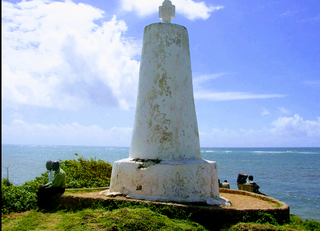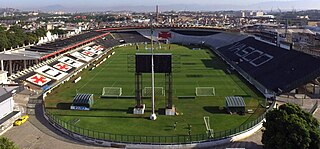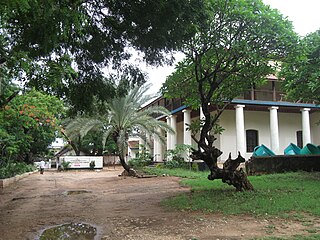
Vasco da Gama, 1st Count of Vidigueira, was a Portuguese explorer and the first European to reach India by sea.

The Vasco da Gama Bridge is a cable-stayed bridge flanked by viaducts that spans the Tagus River in Parque das Nações in Lisbon, the capital of Portugal. It once again became the longest bridge in Europe, taking the spot of the Crimean Bridge, and the longest one in the European Union. As of August 12th, 2023, it is the longest intact bridge in Europe, following missile strikes against the Crimean Bridge. It was built to alleviate the congestion on Lisbon's 25 de Abril Bridge, and eliminate the need for traffic between the country's northern and southern regions to pass through the capital city.

Malindi is a town on Malindi Bay at the mouth of the Sabaki River, lying on the Indian Ocean coast of Kenya. It is 120 kilometres northeast of Mombasa. The population of Malindi was 119,859 as of the 2019 census. It is the largest urban centre in Kilifi County.

The Manueline, occasionally known as Portuguese late Gothic, is the sumptuous, composite Portuguese architectural style originating in the 16th century, during the Portuguese Renaissance and Age of Discoveries. Manueline architecture incorporates maritime elements and representations of the discoveries brought from the voyages of Vasco da Gama and Pedro Álvares Cabral. This innovative style synthesizes aspects of Late Gothic Flamboyant architecture with original motifs and influences of the Plateresque, Mudéjar, Italian, and Flemish architecture. It marks the transition from Late Gothic to Renaissance. The construction of churches and monasteries in Manueline was largely financed by proceeds of the lucrative spice trade with Africa and India.

Estádio Vasco da Gama, also known as São Januário, owing to its location on a street of the same name, is the home ground of Club de Regatas Vasco da Gama. Its facade is listed by the National Historical and Artistic Heritage.

The Jerónimos Monastery or Hieronymites Monastery is a former monastery of the Order of Saint Jerome near the Tagus river in the parish of Belém, in the Lisbon Municipality, Portugal. It became the necropolis of the Portuguese royal dynasty of Aviz in the 16th century but was secularized on 28 December 1833 by state decree and its ownership transferred to the charitable institution, Real Casa Pia de Lisboa.

Belém is a freguesia and district of Lisbon, the capital of Portugal. Belém is located in western Lisbon, to the west of Ajuda and Alcântara and directly east of Lisbon's border with Oeiras. Belém is famous as a museum district, as the home of many of the most notable monuments of Lisbon and Portugal alike, such as the Belém Tower, the Jerónimos Monastery, the Padrão dos Descobrimentos, and Belém Palace. The population in 2011 was 16,528.

The Vasco da Gama Tower is a 145-metre (476 ft) lattice tower with skyscraper in the civil parish of Parque das Nações, the municipality of Lisbon, in Portugal. Built on the north bank of the Tagus river, it is named after the Portuguese explorer Vasco da Gama. The tower portion is the tallest structure in Lisbon.

Sines is a town and a municipality in Portugal. The municipality, divided into two parishes, has around 14,214 inhabitants (2021) in an area of 203.30 km2 (78.49 sq mi). Sines holds an important oil refinery and several petrochemical industries. It is also a popular beach spot and the main fishing harbor of Alentejo region.

Vasco da Gama, often shortened to Vasco, is a city in the state of Goa on the west coast of India. It is named after the Portuguese explorer Vasco da Gama. It is the headquarters of the Mormugão taluka (subdistrict). The city lies on the western tip of the Mormugao peninsula, at the mouth of the Zuari River, about 30 kilometres (19 mi) from Panaji, Goa's capital, 28 kilometres (17 mi) from Margao, the district headquarters and about 5 kilometres (3.1 mi) from Dabolim Airport.

A padrão is a stone pillar left by Portuguese maritime explorers in the 15th and 16th centuries to record significant landfalls and thereby establish primacy and possession. They were often placed on promontories and capes or at the mouths of major rivers. Early markers were simple wooden pillars or crosses but they deteriorated quickly in the tropical climate where they were often erected. Later, padrões were carved from stone in the form of a pillar surmounted by a cross and the royal coat of arms.

The Cathedral of Évora is a Roman Catholic church in the city of Évora, Portugal. It is one of the oldest and most important local monuments, lying on the highest spot of the city. It is part of the historical city centre, and the seat of the Archdiocese of Evora.

Swahili architecture is a term used to designate a whole range of diverse building traditions practiced or once practiced along the eastern and southeastern coasts of Africa. Rather than simple derivatives of Islamic architecture from the Arabic world, Swahili stone architecture is a distinct local product as a result of evolving social and religious traditions, environmental changes, and urban development.

São Gabriel was the flagship of Vasco da Gama's armada on his first voyage to India in 1497–1499.

The Portuguese discovery of the sea route to India was the first recorded trip directly from Europe to the Indian subcontinent, via the Cape of Good Hope. Under the command of Portuguese explorer Vasco da Gama, it was undertaken during the reign of King Manuel I in 1495–1499. Considered one of the most remarkable voyages of the Age of Discovery, it initiated the Portuguese maritime trade at Fort Cochin and other parts of the Indian Ocean, the military presence and settlements of the Portuguese in Goa and Bombay.

Kenya–Portugal relations are bilateral relations between Kenya and Portugal. Both nations have had relations dating back 500 years since the Age of Discovery.

The Vasco da Gama Pillar in Malindi, Kenya, was erected by the Portuguese explorer Vasco da Gama. It was constructed in 1498 or 1499 during his pioneering maritime expedition from Lisbon to India via the Cape of Good Hope (1497–99).

The Portuguese Chapel in Malindi, Kenya, was built c.1502 by the residents of the Portuguese factory established by Vasco da Gama during his second voyage to India. It was the first Christian place of worship to be built in East Africa.

The House of Columns in Malindi is part of Malindi Museum. It was first opened as 'Malindi Museum' on 10 May 2004. In 2014, Malindi Museum acquired an additional set of buildings: the former offices of the Malindi District Commissioner, 400 metres west along Silversand Road. Since that time, the 'House of Columns' has been known by its old name, while the new buildings are known as the Malindi Heritage Complex.

The Malindi Museum Heritage Complex consists of a group of buildings occupied by Malindi Museum in Kenya. The main building on the site is a historic building used for public displays that focus on the cultures of the past and present people of the coastal region. The rooms on the ground floor contain exhibitions dedicated to Swahili culture, as well as underwater cultural heritage. Upstairs are exhibitions on the Mijikenda and Taita / Dawida people.






















